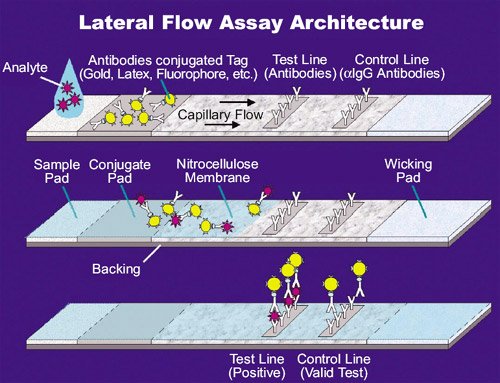Hello Steemit!
Pregnancy. It is something that almost everyone worries about, for one reason or another, at some point in their lives. Whether you try to get pregnant or avoid pregnancy, the standard at-home pregnancy test is often the weapon of choice when you think you might be pregnant.

The over-the-counter pregnancy test, is a small stick made of plastic that you pee on. They use techniques called "lateral flow" and "immunochemistry" for detecting the hormone hCG. hCG stand for human ChorioGonadotropin.
HCG is made up of an α- and a β-chain. The β-chain is the same as that of a few other hormones that I won't go into in this post. What is important is the hormone itself, containing both chains.
Human Choriogonadotropin
The hCG hormone is produced in the placenta. When a woman gets pregnant, elevated levels of hCG can be detected just 6-8 days after conception. This makes hCG the earliest marker of pregnancy. hCG's function is protecting the corpus luteum (a part of the ovary), which in turn allows it to secrete another hormone called progesterone. Progesterone prepares the uterus for the fetus.
You might have heard that if a guy tries to pee on a pregnancy test, and it comes up positive, he should seek medical attention. This is because certain tumours in the testicles can produce hCG, making a pregnancy test positive. This is also true for some tumours in the ovaries.
Principle of analysis
This picture shows pretty well how the lateral flow immunochemistry in a pregnancy test works.

On the test stick, is a small sponge-like fabric that soaks up the sample (the urine). The sample then starts to move along the strip, and enters an area with antibodies specifically made to bind hCG. These antibodies are bound to particles (often latex particles), that are later used to display a positive or negative.
A positive sample will start to bind to the antibodies, as it moves further down the test strip. The incubation and binding of the anti-hCG to the hCG hormone takes some time. This is why you have to wait a few minutes before seeing the result of the test.
As the hCG/anti-hCG complex travels further down the strip, it encounters more anti-hCG antibodies. These are bound to the test strip on one end and bind to the complex on the other. This forms a sandwich of strip-bound antibody/hCG/particle-bound antibody. Because the new antibodies are bound to the test strip, they prevent the hCG from he sample from travelling further down the strip. However, excess antibodies from the initial binding will continue down and reach the control strip. Here, antibodies created to bind the excess antibodies wait for them. If this part is not coloured after a while, the test is invalid.
In order for a pregnancy test to be positive, both the test strip, and the control strip needs to be coloured. The colour (and the molecules responsible for them) varies from brand to brand.
Blood test
hCG can also be detected in blood. This is more reliable than the at-home urine test, as lower concentrations of hormones can be detected.
The principle of analysis is similar to that in the at-home test, though.
hCG is bound to two specific antibodies for hCG. They form a sandwich with the hormone. One side is magnetic, and the other can light up when exposed to a charge. The sandwich principle means that after holding back the magnetic particles, the unbound antibodies can be washed away. By exposing the reaction mixture to a charge, light is produced. The intensity of the light, is the directly proportional with the concentration of hCG!

This shows the sandwich principle pretty well. However, it uses an enzymatic reaction instead of an applied voltage. The detection principle is the same, though, as light is absorbed in a photomultiplier.
Bear in mind, that not all laboratories perform all tests the same way. It all comes down to what equipment is and assay-type is available.
---
If you like my post, feel free to leave a comment and an upvote, and if you have any questions, please ask and I'll do my best to answer them.
~
Decadence